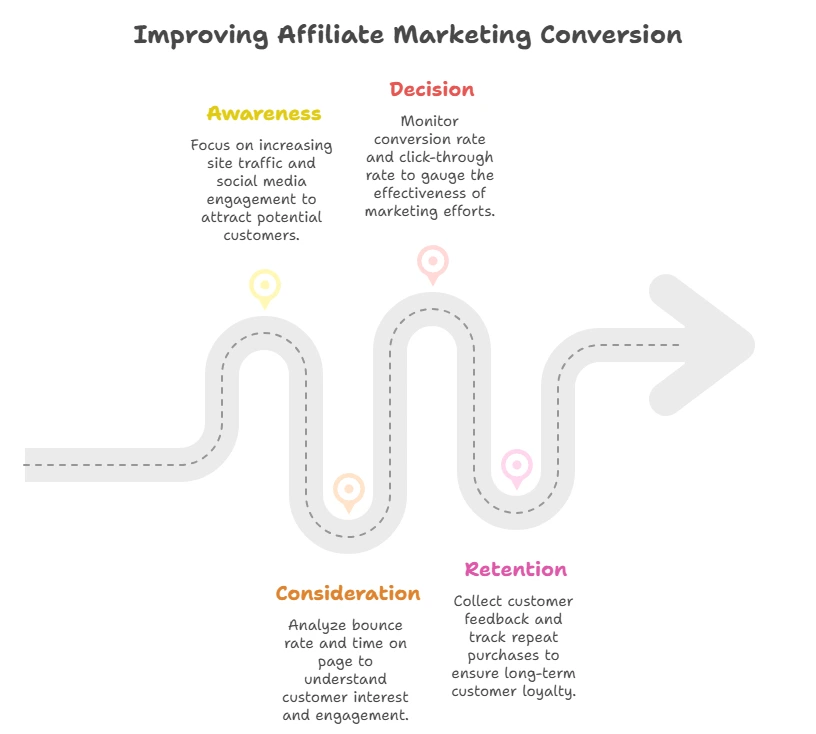
Boosting your Affiliate Marketing Conversion Rate is crucial for increasing your earnings and growing your business. There are many strategies to enhance your results, and applying them can lead to significant improvements. Here are some effective methods to consider:
Understand Your Audience
Knowing your audience is key to increasing your conversion rate. Conduct research to identify their needs, preferences, and pain points. Use surveys, social media polls, and analytics to gather data about your audience. Tailoring your content to address their specific concerns will help you connect better and motivate them to take action.
Optimize Your Content
High-quality content is essential for converting visitors into customers. Make sure your blog posts, reviews, or promotional content are informative, engaging, and easy to read. Here are some tips:
- Use clear and compelling titles: Titles should grab attention while hinting at the content.
- Emphasize benefits: Highlight how your product or service solves problems and improves users’ lives.
- Incorporate visuals: Add images, videos, or infographics to make your content more engaging.
Build Trust with Transparent Reviews
Your audience needs to trust you before making a purchase. One way to build trust is by providing honest and transparent reviews of products. Mention both pros and cons, and share personal experiences with the product. This approach can help you establish credibility and lead to higher conversion rates.
Create Strong Calls-to-Action (CTAs)
A clear and compelling CTA is crucial for guiding visitors toward the desired action. Keep these tips in mind:
- Be specific: Use action-oriented phrases like “Buy Now,” “Sign Up Today,” or “Get Your Free Trial.”
- Make them stand out: Use contrasting colors and larger fonts to draw attention to your CTAs.
- Position strategically: Place CTAs in prominent locations throughout your content to capture interest.
Leverage Email Marketing
Email marketing remains one of the most effective strategies for affiliate marketers. Building an email list allows you to connect with your audience directly. Here are some ideas to utilize:
- Nurture leads: Send valuable content, tips, and product recommendations through your newsletters.
- Utilize segmentation: Categorize your email list based on subscriber interests to send more personalized content.
- Run special promotions: Offer exclusive discounts or bonuses to your email subscribers to encourage purchases.
Utilize Social Proof
Social proof is a powerful motivating factor for potential customers. Including customer reviews, testimonials, and case studies can significantly enhance your credibility. Here are ways to leverage social proof:
- Create testimonial pages: Showcase satisfied customers and their experiences with the products you promote.
- Share user-generated content: Encourage your audience to share their experiences on social media and highlight these stories on your website.
Test Different Strategies
Continually testing and optimizing your strategies can lead to better results over time. Run A/B tests on your CTAs, landing pages, and email campaigns. Monitor the performance of different content styles and messaging to see what resonates best with your audience.
Utilize Analytics Tools
Monitoring your performance is critical for ongoing success. Use analytics tools to track your website traffic, conversion rates, and customer behavior. Tools like Google Analytics can provide valuable insights into what is working and what needs improvement. Take advantage of this data to adjust your approach and increase your conversion rates.
Implementing these strategies can help you significantly boost your Affiliate Marketing Conversion Rate. For more detailed insights, check out resources like Affiliate Programs and CJ Affiliate. Remember, understanding your audience and crafting tailored solutions are keys to successful affiliate marketing.
By applying these tactics and maintaining a focus on quality and engagement, you’ll be well on your way to transforming your affiliate marketing efforts into a profitable venture!
Understanding the Customer Journey in Affiliate Marketing
Understanding the customer journey in affiliate marketing is essential for driving conversions and maximizing profits. By focusing on the various stages of the journey, businesses can better tailor their marketing strategies to meet customer needs. This awareness can greatly improve your Affiliate Marketing Conversion Rate.
The Stages of the Customer Journey
The customer journey consists of several key stages:
- Awareness: In this initial phase, potential customers realize they have a need or problem. This is where affiliate marketers aim to reach them through engaging content or targeted advertisements.
- Consideration: Customers begin comparing options. They research different solutions and evaluate the benefits of each product. Affiliates must provide thorough comparisons and informative content to guide their decisions.
- Decision: Here, customers make their purchasing decision. Effective affiliate marketing strategies during this stage can include compelling calls to action and trust-building elements, such as customer testimonials.
- Retention: After the purchase, keeping customers engaged is vital. Ongoing communication and offering value can transform first-time buyers into loyal customers. Feedback surveys and follow-up emails can strengthen this relationship.
Importance of an Effective Strategy
Building an effective affiliate marketing strategy that resonates with each stage of the customer journey is essential. You need to evaluate the needs and concerns of your target audience.
Consider the following methods that can enhance your marketing efforts:
- High-Quality Content: Create engaging and informative content. Blogs, videos, and infographics can significantly improve your chances of capturing customer interest.
- SEO Optimization: Optimize your affiliate links and content for search engines. This will ensure that your content is discoverable by users seeking relevant information.
- Targeted Advertising: Use targeted ad campaigns to reach specific demographics. Tailored ads increase the likelihood of potential customers clicking on your affiliate links.
Measuring the Customer Journey
To improve your Affiliate Marketing Conversion Rate, it’s crucial to measure each stage of the customer journey. Analytics tools can provide valuable insights:
| Stage | Key Metrics |
|---|---|
| Awareness | Site Traffic, Social Media Engagement |
| Consideration | Bounce Rate, Time on Page |
| Decision | Conversion Rate, Click-Through Rate |
| Retention | Customer Feedback, Repeat Purchases |
Engaging Customers Effectively
Engagement is crucial in the customer journey. Providing valuable resources can encourage trust and foster relationships:
- Webinars: Offering educational webinars allows you to connect with your audience on a deeper level.
- Exclusive Deals: Provide exclusive offers or discounts through your affiliate links to entice customers to make a purchase.
- Community Building: Create forums or social media groups for customers interested in your niche. This fosters a sense of belonging and loyalty.
Final Thoughts on the Customer Journey
Understanding and optimizing the customer journey is paramount for increasing your Affiliate Marketing Conversion Rate. By addressing the needs of customers at every stage, you can create a seamless experience that drives engagement and successful sales.
For further insights into maximizing your affiliate strategies, consider exploring resources from industry leaders such as Affiliate Institute and Blogging Success. These platforms provide valuable tips and strategies tailored to affiliate marketers.
The Role of Content Quality in Conversion Rates
In affiliate marketing, the conversion rate is crucial to your success. But what drives those conversion rates? One major factor is content quality. High-quality content not only attracts visitors to your site but also convinces them to take action. Let’s dig deeper into how content quality impacts conversion rates.
Quality content is engaging, informative, and valuable. When your audience finds what they need quickly and easily, they’re more likely to trust you and, ultimately, convert. Here are some key points to consider:
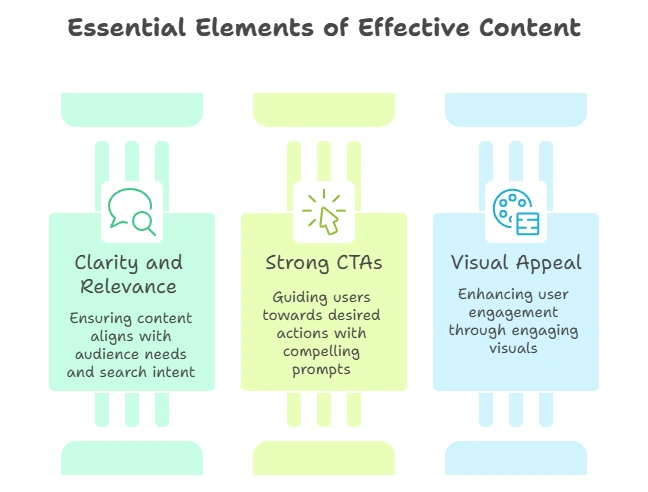
- Clarity and Relevance: Your content should speak directly to your audience’s needs and interests. It must be clear and relevant to the keywords they are searching for.
- Strong Calls-to-Action (CTAs): Well-placed and compelling CTAs guide users toward the action you want them to take, whether it’s signing up for a newsletter or making a purchase.
- Visual Appeal: images, videos, or infographics can enhance the user experience and keep visitors on the page longer, increasing the chance of conversion.
Furthermore, the type of content you produce can affect your conversion rates. For example, product reviews, how-to guides, and case studies can lead to higher engagement. Consider these options:
- Product Reviews
- How-To Guides
- Customer Testimonials
- Case Studies
- Comparative Articles
Each type serves a different purpose but ultimately boosts conversion rates by creating trust and authority in your niche. Users want to know that they are making informed choices, and well-crafted content does just that.
It’s also essential to focus on SEO. By optimizing your content for search engines, you increase visibility, which can drive more traffic to your site. However, keyword optimization should not overshadow content quality. Search engines like Google prioritize user experience, and low-quality content can hurt your rankings.
Below is a simple table to illustrate how content quality rankings correlate with conversion rates:
| Content Quality Rating | Estimated Conversion Rate |
|---|---|
| Very High | 6–10% |
| High | 3–5% |
| Medium | 1–2% |
| Low | 0–1% |
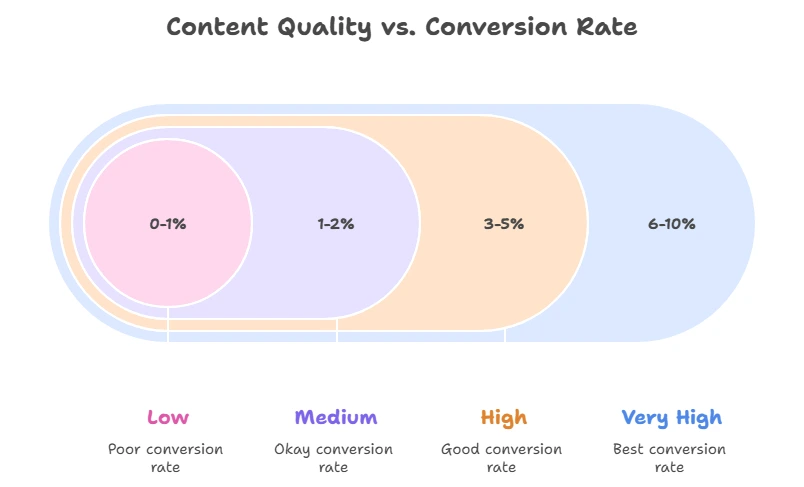
As demonstrated, the quality of your content can have a significant effect on conversion rates. Investing time in producing high-quality, relevant content can pay off in increased conversions. Besides, using tools to analyze your audience and track their behavior can provide insights into what content resonates the most with them. Pay attention to user comments and feedback; they often reveal areas for improvement.
Additionally, consider employing A/B testing. By creating variations of your content—such as different headlines, images, or CTAs—you can see what performs best. This trial-and-error method can help refine your approach and further enhance your conversion rates.
Focusing on content quality leads to better engagement, user satisfaction, and ultimately higher conversion rates. Aspiring affiliate marketers should prioritize crafting well-researched, well-written content that meets the needs of their target audience. Explore Ahrefs for more insights on improving content quality.
By combining quality content with effective SEO strategies and constant testing, you’ll be well on your way to achieving impressive conversion rates in your affiliate marketing efforts.
Don’t forget to update your content regularly. Trends change, and so do audience preferences. Staying relevant is key to maintaining your audience’s interest and ensuring continued conversions. Continuously seek out new strategies and ideas to keep your content fresh and engaging.
Effective Use of Social Proof to Increase Conversions
Many businesses struggle to increase their Affiliate Marketing Conversion Rate. One effective strategy that can significantly boost conversions is the use of social proof. Social proof is the psychological phenomenon where people look to the behavior of others to inform their own decisions. By showcasing the positive experiences of previous customers, you can influence potential buyers to take action.
Here are several types of social proof that can effectively increase your conversions:
- Customer Testimonials: Displaying testimonials from satisfied customers can build trust and credibility. When potential buyers see that others have had positive experiences with your product, they are more likely to make a purchase.
- Product Reviews: Encouraging customers to leave reviews can create a wealth of social proof. Ratings and reviews provide insights into the product and let prospective buyers gauge its quality and effectiveness. A higher average star rating can lead to increased conversions.
- Case Studies: In-depth case studies that show how your product has helped customers can effectively illustrate its value. Real-life success stories resonate with users and can motivate them to take action.
- Influencer Endorsements: Collaborating with influencers can dramatically enhance your credibility. When trusted personalities endorse a product, their followers are more likely to convert, driven by the influencer’s approval.
- Social Media Mentions: Showcasing your product on social media and highlighting mention in posts can serve as powerful social proof. It demonstrates an active customer base and encourages others to join in.
Integrating these forms of social proof into your marketing strategy can lead to higher engagement and a better Affiliate Marketing Conversion Rate. Interaction is critical, and fostering a community around your brand can significantly enhance how customers view it. Here are tips to effectively use social proof:
- Feature Testimonials Prominently: Use them on your homepage, product pages, and during the checkout process.
- Utilize Visuals: Images or videos of happy customers using your product can evoke emotional responses which drive conversions.
- Keep It Current: Regularly update your testimonials and reviews to ensure they reflect the most recent experiences of customers.
- Encourage User-Generated Content: Ask your customers to share their experiences on social media and tag your brand. This content is perceived as more authentic and relatable.
Measuring the efficacy of your social proof strategies is essential. To track their impact on your Affiliate Marketing Conversion Rate, consider the following metrics:
| Metric | Description | How to Use |
|---|---|---|
| Conversion Rate | The percentage of visitors who take a desired action (buying a product) | Analyze the change in conversion rates before and after implementing social proof |
| Engagement Rate | How actively users interact with your content | Measure likes, shares, and comments on social proof content |
| Customer Acquisition Cost (CAC) | Cost associated with acquiring a new customer | Evaluate if social proof reduces CAC over time |
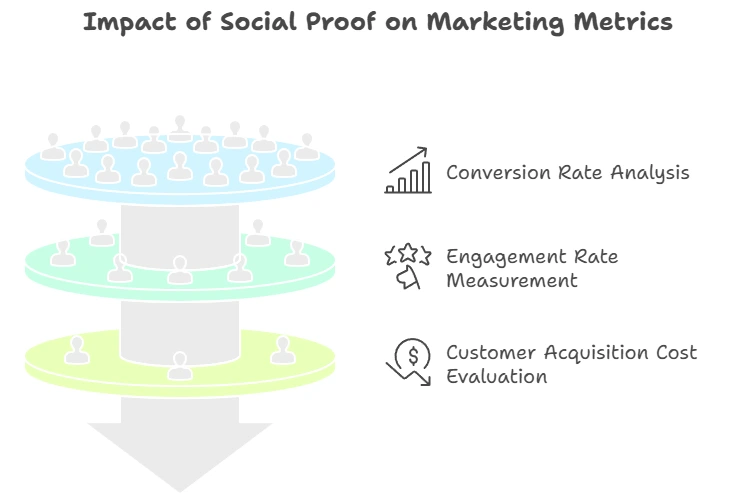
Integrating social proof into your marketing strategy isn’t just about adding testimonials and reviews. It’s about creating a narrative that resonates with potential customers. It demonstrates a community of satisfied users who trust your product. Capsizing potential doubts with real-life success stories creates an emotional connection that can lead to increased conversions.
To master social proof, keep these key points in mind:
- Be Authentic: Authenticity is vital. Customers can tell when testimonials aren’t genuine, and it can negatively affect your credibility.
- Encourage Reviews: Implement a simple review system that encourages customers to share their feedback easily.
- Highlight Badges and Awards: If your product has received any accolades, make sure to display those proudly, as they serve as a form of social proof.
To see real-world examples of effective social proof in action, check out resources like ConversionXL and Neil Patel’s blog. They provide insights and case studies highlighting how brands leverage social proof to enhance their conversion rates.
Social proof in your efforts can be an influential strategy for improving your Affiliate Marketing Conversion Rate. By focusing on genuine customer experiences and feedback, you can build a trustworthy image and drive more sales effectively.
Analyzing Metrics: What Affects Affiliate Marketing Success
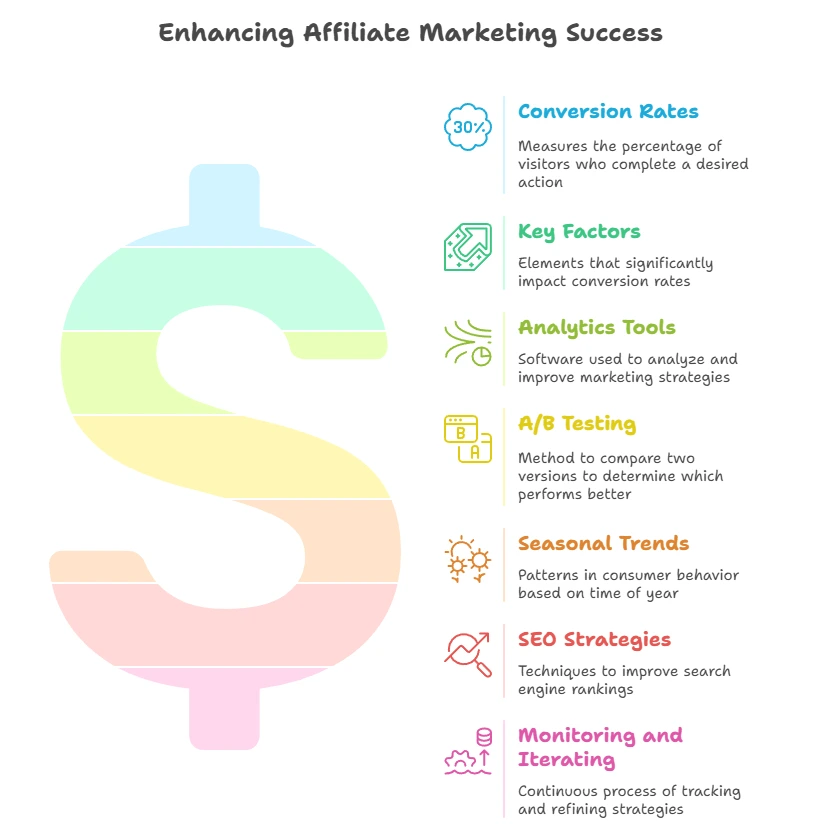
In the realm of affiliate marketing, understanding the factors that affect success is crucial for every marketer. Your conversion rate — the percentage of users who take a desired action — directly ties to your success. A higher conversion rate means more profit from your marketing efforts. Here, we’ll break down key metrics and elements that can help enhance your affiliate marketing results.
Understanding Conversion Rates
Your conversion rate is determined by dividing the number of conversions by the total visitors, multiplying the result by 100 to get a percentage. For instance, if 100 people visit your affiliate link and 5 make a purchase, your conversion rate is 5%. Keeping track of this metric helps gauge the effectiveness of your campaigns and the strategies you employ.
Key Factors Influencing Conversion Rates
Several aspects can either boost or hinder your affiliate marketing efforts. Below are some key factors to consider:
- Target Audience: Understanding your audience is essential. Ensure your content resonates with their interests and needs. Segmenting your audience helps tailor your message further.
- Your Offer: The attractiveness of your offer beckons potential customers. Competitive pricing, valuable bonuses, or limited-time discounts can enhance your appeal.
- Quality of Traffic: An essential metric is where your traffic comes from. Organic traffic often converts better than paid traffic. Moreover, targeted traffic, which is specifically seeking your offering, is more likely to convert.
- Content Quality: Comprehensive, engaging, and valuable content will draw in your audience. Use storytelling, visual images, and persuasive language to keep them interested.
- Call-to-Action (CTA): Your CTA drives users to take action. Clear, compelling CTAs encourage immediate responses, so make sure they stand out in your content.
- Landing Page Design: A user-friendly, aesthetically pleasing landing page can significantly improve conversion rates. Ensure it’s mobile-friendly, loads quickly, and has easy navigation.
- Trust Elements: Building trust enhances conversions. Use testimonials, reviews, and clear refund policies to let your audience know they are making a safe choice.
Using Analytics Tools for Improvement
To analyze metrics effectively, using analytics tools is vital. Platforms like Google Analytics can provide insights into user behavior. You can track key metrics, such as bounce rates, traffic sources, and average session duration, enabling better-informed marketing strategies.
A/B Testing for Optimization
Implementing A/B testing can yield significant insights into what works best for your audience. By comparing two versions of a landing page, email, or ad, you can assess which version leads to higher conversions. Critical elements to test include:
- Headlines
- Images
- CTA buttons
- Color schemes
- Content layout
Tracking Seasonal Trends
Seasonal trends can profoundly affect your affiliate marketing success. Most purchases follow seasonal cycles – for instance, shoppers tend to buy more during holidays or special events. By recognizing these patterns in traffic and conversion trends, you can adjust your campaigns accordingly, ensuring your offers are aligned with user expectations.
SEO Strategies
Search Engine Optimization (SEO) plays a crucial role in your affiliate marketing success. By optimizing your content with relevant keywords, improving site speed, and ensuring mobile compatibility, you enhance your page’s visibility in search engines. Learn more about employing effective SEO strategies with resources from Moz and Search Engine Journal.
Monitoring and Iterating
The affiliate marketing landscape continuously evolves. Thus, consistently monitoring your metrics helps you iterate and optimize your strategies effectively. Set monthly or quarterly reviews to analyze trends, track changes, and adapt your approach based on performance metrics.
By paying close attention to these various aspects, you can significantly enhance your Affiliate Marketing Conversion Rate. In this competitive space, taking the time to analyze and refine your strategies not only boosts your ROI but solidifies your position as a valuable resource for your audience.
Conclusion
Boosting your Affiliate Marketing Conversion Rate involves a combination of strategic planning and a deep understanding of your audience. By focusing on the customer journey, you can tailor your approach to meet potential buyers at every critical touchpoint. Recognizing the importance of how customers move through their buying process allows you to create targeted content that addresses their needs and concerns.
Quality content plays a pivotal role in this equation. Engaging, informative, and well-crafted content not only captures attention but also builds trust—a crucial factor in making conversions. Combine this with social proof, such as testimonials and user reviews, and you can significantly enhance your credibility. Customers are more likely to convert when they see that others have had positive experiences with your recommendations.
Tracking and analyzing relevant metrics is essential to understand what impacts your affiliate marketing success. Regularly assessing these metrics will show you which strategies are working and which need adjustment, helping you refine your approach continuously.
By implementing these strategies, you can create a more effective affiliate marketing campaign that not only drives traffic but also motivates conversions. Remember, the key is to always put your audience first, delivering value at every opportunity. With dedication to understanding your customers and refining your methods, you will witness your Affiliate Marketing Conversion Rates climb steadily.
